Get our rates or afixed-price quote!
"*" indicates required fields
Contact
K&C (Krusche & Company GmbH)
St.-Pauls-Platz 9
80336 Munich
Germany
A few of the partners we’re proud to be trusted by:


Software developers are sought after everywhere and are accordingly well paid. But there is still a huge salary range across the profession, with individual take home pays influenced by factors including seniority, role, tech stack, and geography.
The annual State of JavaScript report surveyed, among other things, the annual income of software developers. Of the total of 28,693 respondents from 20 countries, the majority (20.6%) reported an annual income of $50,000-100,000, 12.5% earned $30,000 to $50,000 a year, and 13.7% earned $100,000 to $200,000.
23.2% earned $30,000 or less annually and about 3% over $200,000. However, this statistic could well provide a somewhat distorted picture, as more than one in four (27.4%) of respondents declined to answer.


Source: State of JS 2022
In the U.S., software developers have the highest average annual income in California ($134,370), followed by Washington State ($73,967). Information on the average annual income of software developers varies between $76,000 and $120,000. What is certain, however, is a steady upward trend in the salaries commanded by professional coders over the past 10 years. (US News, PayScale)
According to Statista, a coder’s income also depends heavily on their exact role, function and skillset. While a senior executive earned about $200,000 annually in 2022, a QA or test developer only received around $120,000 annually.


Source: Statesman
With the increasing demand, which is reflected, among other things, in attractive salaries, the number of software developers is also increasing. There are an estimated 26.8 million software developers worldwide (and rising: experts predict that there will be about 45 million developers by 2030). About 4.3 million software developers (the most within a country) are based in the US, while there are over 6 million software developers in Europe. The American Bureau of Labor Statistics expects the demand for software developers to increase by 22% by 2029. There is already a shortage of qualified developers. (Future Processing)
Statista forecasts an increase in the number of software developers to 27.7 million in 2023 and 28.7 million in 2024. In Europe, Germany (873,398) is home to the most software developers, closely followed by the UK (813,500) and – by some distance – France (477,454). The fastest-growing regions for software development and coders include Latin America, the Asia-Pacific region and India (the latter is expected to replace the US as the largest developer nation as early as 2024). (GridDynamics)
The demand for app developers is also steadily increasing, with Asia, Europe and North America each home to about one-third of the world’s app developers. However, Asia is slightly ahead with 32.9% (ahead of Europe with 29.7% and North America with 29.4%). (Treinetic)
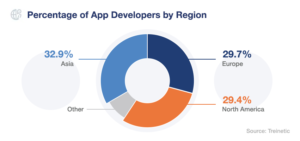

How did the CoViD-19 pandemic affect the way software developers work?
As with all industries, the coronavirus pandemic has had an impact on the IT sector. Working from home, or remotely, has become much more popular since the pandemic. This trend is also noticeable in the IT sector, but the home office was already very common here, as the following statistic shows:


Source: Statesman
However, the trend towards remote work in the IT industry has also been fueled by the pandemic. About three-quarters of software developers are currently working from home at least some days a week.
According to Statista, JavaScript was the most popular programming language among software developers worldwide in 2022: 65.36% of all respondents said they use JS, followed by HTML/CSS (55.08%), SQL (49.43%) and Python (48.07%).
An important reason for JavaScript’s popularity is its large and therefore influential community of around 13.8 million software developers. (Developer Tech)
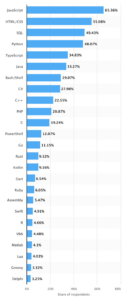

Source: Statesman
In terms of the operating systems coders use, Windows has been stably ahead in recent years. 61% of software developers surveyed used Windows in 2022. macOS follows in second place with 46%, narrowly overtaking Unix/Linux compared to the previous year, which now follows in third place with 45%.
At the beginning of every software development project, the question arises as to which libraries and frameworks should be used. Global trends can provide a decision-making aid.
According to Statista, the world’s most popular libraries and frameworks in 2022 were NET with 34.55%, NumPy with 28.65% and Pandas with 25.08%.
Again according to Statista, the most popular web framework among software developers in 2022 was Node.js, which was used by 47.12%. React.js followed in second place with 42.62% and in third place – with some distance – jQuery with 28.57%.
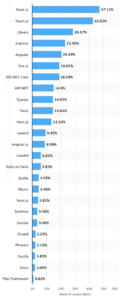

Source: Statesman
The following chart shows the evolution of the use of cross-platform mobile frameworks by software developers from 2019 to 2021:


Source: Statesman
While Facebook’s React Native was still clearly in the lead in 2019 with 42% of users, enthusiasm for the framework declined somewhat to 38% of users by 2021. Google’s Flutter, on the other hand, caught up: in 2019, 30% of software developers used Flutter, and in 2021 this figure had risen to 42%. Flutter has now replaced React Native as the most used mobile application development framework.
Other frameworks such as Cordova, Ionic or Xamarin, which in 2019 still threatened to compete with the two giants at the top, all fell back to well below 20% market share. More recent data for the development in 2022 are currently still pending.
According to Statista, the most popular cloud platform among software developers in 2022 was AWS (Amazon Web Services): 34.34% used this cloud. In second place were Google Cloud (18.14%) and Microsoft Azure (15.57%).


Source: Statesman
According to Statista, in 2022, the vast majority of software developers involved in mobile app programming, at 87%, programmed for Android. Significantly less, namely 60% programmed (also) for iOS. Other mobile operating systems hardly played a role (3%).
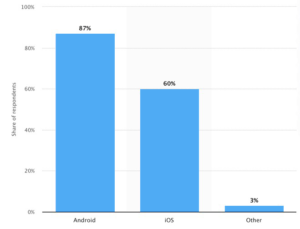

Source: Statesman
According to the latest State of JavaScript report from 2022, the vast majority of software developers are still male, namely 70.1% of participants. On the other hand, only 4% are female. However, almost a quarter of the participants (24.6%) did not answer the question, which could represent a significant shift in distribution, but does not change the fact that women are still underrepresented in the software development industry.
GridDynamics research shows 19.3% of software developers in the U.S. are women, and globally, the figure is as high as 27.5%. This could indicate women concealed their gender more often than men in the State of JS report.
Most (42.2%) of the software developers surveyed in the 2022 State of JS report have between 3 and 10 years of professional experience. Only 5.5% have more than 20 years of experience. Even fewer, 3.3%, reported a professional experience of less than one year – either the young professionals simply did not take part in the report so far or there is a shortage of young talent in the industry – let’s hope the former! Again, almost a quarter of respondents (24%) failed to answer.


Source: State of JS 2022
According to StackOverflow, software developers in Australia have the longest work experience at an average 16.9 years, followed by the UK (16.1 years) and the US (15.8 years). In Germany the average professional experience is 14.3 years and India brings up the rear at an average of 8.1 years.
Statistics show that, on average, software developers are relatively young. The average age of software developers is between 25 and 34 years old.
According to the latest State of JS report, 36.5% of all respondents were in this age range, 14.9% were between 19 and 24 years old and 16.5% were between 35 and 44 years old. Only 5% are over 44 years old.


Source: State of JS 2022
StackOverflow paints a very similar picture: according to their statistics, 39.52% of software developers are between 25 and 34 years old, 25.47% are between 18 and 24 years old, and 18.42 are between 35 and 44 years old. If you limit the statistics to professional software developers, as many as 48.42% are between 25 and 34 years old.
The highest average age is in the US at 33.7 years, closely followed by the UK (33.1) and Canada (32.2). With an average of 30.9 years of software developers, Germany ranks in the middle of the pack, just behind the Netherlands (31.9) and ahead of France (30.4). The lowest average age is in India at 26.0 years. (StackOverflow)
Looking at the size of the company, almost a third (32%) of software developers work in companies with more than 100 employees. On the other hand, 9% work in one-man (rarely one-woman) companies. The rest work in companies with 2 to 100 employees (32.7%) or did not answer this question (26.7%). (State of JS 2022)
At one third (33.6%), the majority of respondents work in the “programming and IT services” sector. The “E-Commerce & Retail” sector follows in second place with 21.8%, followed by “Finance” (12.6%) and “Education” (10.5%) in third and fourth place. (State of JS 2022)
Three-quarters (75.6%) of software developers use JavaScript for front-end development, about half (50.1%) for back-end development, and about one-fifth (20.8%) for mobile apps. (State of JS 2022)
More than half (56.4%) of the software developers surveyed by the State-of-JS report said that they had learned programming autodidactically. Free online courses were also very popular with 40.6%, as were videos and screencasts (38.8%). Only one in five software developers (21.5%) stated that they had acquired their programming skills through school or higher education.
A slightly different picture emerged in a survey conducted by StackOverflow in 2021: Here, 53.59% of respondents said they had learned programming at school. Online videos, blogs etc. ranked 1st here with 59.53%.
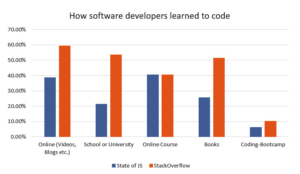

Source: State of JS, StackOverflow
In 2020, nearly 85% of respondents to StackOverflow considered official education to be at least “somewhat important,” and over a third (34.3%) even considered “very important” or “extremely important.”
The State of JS report also asked what sources software developers use to stay up to date. Among blogs and magazines, Medium is the most popular: 44.8% of respondents said they read content on the platform. In second place is the blog Dev.to with 39.6% readers among the respondents. CSS-Tricks follows in 3rd place with 18.3%.
For education and training, there are a number of websites that software developers like to consult with questions or problems. The most popular site is StackOverflow: 67.5% of respondents said they visit this site regularly. This is closely followed by MDN with 58.8% and – some way behind – W3Schools with 37.1%.
As with all conceivable topics these days, there are also various podcasts developed for an audience of professional coders. Syntax is heard by 8.6% of respondents, making it the most popular among JS programmers. JS Party follows in second place (4%), followed by http 203 (3.8%) in third place.
Last but not least, we look at the most popular influencers on YouTube, Twicht, TikTok and other social media platforms. 39% of those surveyed in the State of JS report said they follow the creator Fireship. Kevin Powe l l l had less than half as many followers (16.1%) among the respondents. The third most popular channel is Web Dev Simplified with 14.1%.